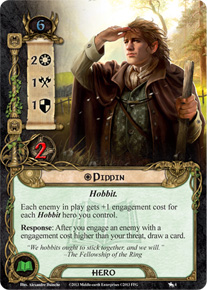Welcome to Card Game DB
Register now to gain access to all of our features. Once registered and logged in, you will be able to create topics, post replies to existing threads, give reputation to your fellow members, get your own private messenger, post status updates, manage your profile and so much more. If you already have an account, login here - otherwise create an account for free today!
Register now to gain access to all of our features. Once registered and logged in, you will be able to create topics, post replies to existing threads, give reputation to your fellow members, get your own private messenger, post status updates, manage your profile and so much more. If you already have an account, login here - otherwise create an account for free today!
Pippin
Submitted
Darksbane
, Sep 07 2013 06:25 AM | Last updated Sep 07 2013 06:25 AM

Type: Hero Sphere: Lore Threat Threshold: 6 Willpower: 2 Attack: 1 Defense: 1 Hit Points: 2 Hobbit. Each enemy in play gets +1 engagement cost for each Hobbit hero you control. Response: After you engage an enemy with a engagement cost higher than your threat, draw a card. "We hobbits ought to stick together, and we will." - The Fellowship of the Ring Set: TBR Number: 4 Quantity: 1 Illustrator: Alexandre Dainche |
© 2011 Fantasy Flight Publishing, Inc., all rights reserved. No part of this product may be reproduced without specific permission. Middle-earth, The Hobbit, The Lord of the Rings, and the characters, items, events and places therein are trademarks or registered trademarks of The Saul Zaentz Company d/b/a Middle-earth Enterprises. Fantasy Flight Games, Fantasy Flight Supply, and the FFG logo are trademarks of Fantasy Flight Publishing, Inc. All Rights Reserved to their respective owners.



 Sign In
Sign In Create Account
Create Account











4 Comments
So, you can draw a card for each enemy, with higer engagement cost, that you engage with, am I right?
Yes. Just like Sam can gain his +1's for each enemy engaged even if engaged at the same time.
This matters for Halbarad who boosts the engagement cost of things engaged to you. If you count it when you declare you are engaging then if player A has Halabarad and player B finds a way to engage that enemy (e.g Tactics Aragorn) then B can count Halbarad's buff for the card draw. Otoh if Player A controls both Pippin and Halbarad then Halbarad would not kick in until after the response had already checked threat and triggered or failed to trigger.
If you count it as triggering after the enemy already counts as engaged with you and then you check Halbarad, then you don't get the card draw in the first example, but now you do in the second.
The same question comes up with Sam Gamgee, and the consensus position seems to be that you check the engagement cost during the Response window rather than remembering its engagement cost from when you declare the engagement. And since the passive effect of Halbarad increases the threat prior to the Response window being open, you can use the higher engagement cost when evaluating the trigger.